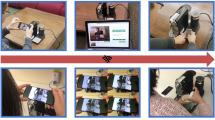Abstract
We describe the architecture and key features of the MPEG-4 Systems specification, as well as the encoding methodology of its various components: scene description and BIFS, animation streams, object descriptors, object content information, as well as delivery and multiplexing. We also describe the MPEG-4 reference software as well as our own prototype software for MPEG-4 authoring, streaming, and playback. Finally, we briefly compare MPEG-4 Systems with a number of currently available alternative standards and commercial solutions.
Similar content being viewed by others
References
ISO/IEC 14496–1, Coding Of Audio-Visual Objects: Systems, Final Draft International Standard, JTC1/SC29/WG11 N2501, Oct. 1998.
ISO/IEC JTC1/SC29/WG11 N2611, MPEG-4 Systems Version 2 WD 5.0, Dec. 1998.MPEG-4 Systems 67
A. Puri and A. Eleftheriadis, “MPEG-4: An Object-Based Standard for Multimedia Coding, ” in Visual Information Representation, Communication, and Image Processing, C.-W. Chen and Y.-Q. Zhang (Eds.), New York: Marcel Dekker, 1999.
ISO Web Site, http://www.iso.ch.
MPEG Web Site, http://www.cselt.it/mpeg.
B.G. Haskell, A. Puri, and A.N. Netravali, Digital Video: An Introduction to MPEG-2, London: Chapman and Hall, 1997.
O. Avaro, A. Eleftheriadis, C. Herpel, G. Rajan, and L. Ward, “MPEG-4 Systems Overview, ” Multimedia Systems, Standard, Networks, A. Puri and T. Chen (Eds.), NewYork: Marcel Dekker, 2000.
A. Eleftheriadis, “Flavor: A Language for Media Representation, ” in Proceedings, ACMMultimedia '97 Conference, Seattle, WA, Nov. 1997.
Flavor Web Site, http://www.ee.columbia.edu/flavor.
C. Herpel, A. Eleftheriadis, and G. Francescini, “MPEG-4 Sys-tems: Elementary Stream Management and Delivery, ” Multime-dia Systems, Standard, Networks, A. Puri and T. Chen (Eds.), New York: Marcel Dekker, 2000.
J. Signes, Y. Fisher, and A. Eleftheriadis, “MPEG-4: Scene Representation and Interactivity, ” Multimedia Systems, Standard, Networks, A. Puri and T. Chen (Eds.), NewYork: Marcel Dekker, 2000.
R. Koenen, “MPEG-4: Multimedia for our time, ” IEEE Spec-trum, vol. 36, no. 2, 1999, pp. 26–33.
C. Herpel and A. Eleftheriadis, “MPEG-4 Systems: Elementary Stream Management, ” Signal Processing: Image Communica-tion, Tutorial Issue on the MPEG-4 Standard, vol. 15, nos. 4–5, 2000, pp. 299–320.
VRML Web Site, http://www.vrml.org.
QuickTime Web Site, http://www.apple.com/ quicktime.
Extensible Markup Language (XML) 1.0, T. Bray, J. Paoli, and C.M. Sperberg-McQueen (Eds.), February 10, 1998, http://www.w3.org/TR/REC-xml.
XHTML TM 1.0: The Extensible HyperText Markup Language. A Reformulation of HTML 4.0 in XML 1.0. W3C Working Draft, February 24, 1999, http://www.w3.org/TR/WD-html-in-xml/.
Synchronized Multimedia Integration Language. (SMIL) 1.0 Specification, June 15, 1998, http://www.w3.org/TR/ REC-smil.
Scalable Vector Graphics (SVG) Specification. W3C Working Draft, February 11, 1999, http://www.w3.org/TR/ WD-SVG.
Author information
Authors and Affiliations
Rights and permissions
About this article
Cite this article
Eleftheriadis, A. MPEG-4 Systems: Architecting Object-Based Audio-Visual Content. The Journal of VLSI Signal Processing-Systems for Signal, Image, and Video Technology 27, 55–67 (2001). https://doi.org/10.1023/A:1008115412798
Published:
Issue Date:
DOI: https://doi.org/10.1023/A:1008115412798




